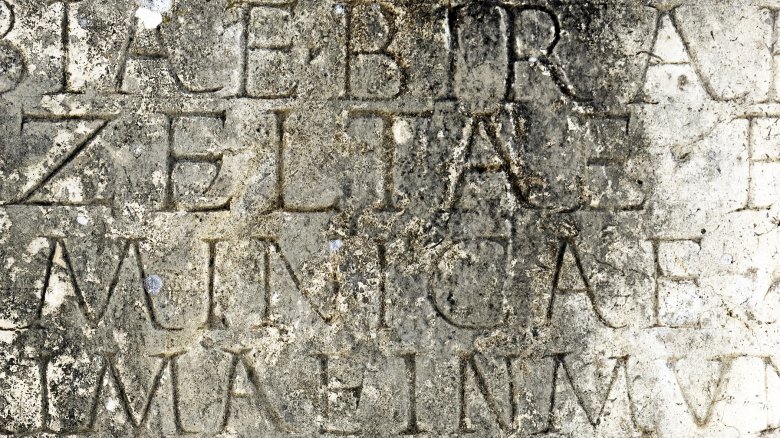Bizarre Things Found Under Parking Lots
There are somewhere between 105 million and 2 billion parking spots in the United States alone. Granted, that's not very specific, but it does say something important about how much real estate the modern world has devoted to making sure there are plenty of places to leave our expensive metal boxes for most of their lives. So it's little wonder that those parking lots are sometimes built on top of archaeological wonders and random dead people, forever doomed to sleep just a few feet below people whose biggest present concern is scoring the closest possible parking spot relative to the front door so they don't have to burn any extra calories crossing the lot on foot. Here are just a few of the weirdest things ever found under parking lots.
Richard III
He was hoping to trade his kingdom for a horse, but instead he got a bunch of cars. And they didn't do him much good, because they arrived like 500 years after his death, and also they were parking more or less on top of him.
He is — or was — Richard III, that most hated monarch of the pre-Tudor era, who may or may not have murdered his own nephews and who most definitely got his butt kicked at the Battle of Bosworth in 1485.
According to the Richard III Visitor Center, finding the long-dead king under a parking lot wasn't something that happened by accident. Historians knew the location of the Grey Friars Church where Richard was buried, and they were pretty sure the best place to look was under the parking lot. All they needed was permission to start digging.
In 2012 archaeologists found a skeleton that showed evidence of 10 wounds consistent with death in battle. And the skeleton also had a dramatically curved spine, which may have inspired Shakespeare's unflattering characterization of the king as "bunchback'd," although in reality Richard's scoliosis wouldn't have been that obvious to most people. DNA testing confirmed the skeleton's identity, but it wasn't until Benedict Cumberbatch read a poem at his funeral that everyone knew it was for real. You're definitely royalty when Benedict Cumberbatch reads a poem at your funeral.
The Fortress of Acra
In the second century B.C., the Greeks were busily taking over cities and wearing togas, but they were having some trouble with Jerusalem. Actually the Greeks didn't wear togas, that was the Romans — but evidently no one ever told the college fraternities, which is why they're still so fond of toga parties. Anyway, back in the days when being Greek meant something other than loud parties and terrifying initiation rituals, the Greeks were trying to control Jerusalem, still occupied by people who stubbornly insisted on being Jewish.
To help maintain their fragile hold over the city, the Greeks built the Fortress of Acra. Far from being the stronghold that brought the Jews to heel, Acra ended up being the site of a long and pitiful siege that didn't end until a lot of people inside starved to death. Archaeologists found the fortress under the Givati parking lot in the City of David, and identified it with the help of some arrowheads, lead slingshots, and stone missiles stamped with the trident of the Greek king Antiochus IV Epiphanes, who today is mostly remembered as the villain of Hanukkah, or the guy who told the Jews they had to stop being Jewish. The ruins of the old fortress are impressive, but not impressive enough — the Jews are still Jewish, still living in Jerusalem, and up until recently also parking their cars on top of the stronghold that was supposed to keep them in line.
Hitler's death bunker
Everyone loves the story about Hitler killing himself because if it was ever okay to clap your hands and say "woot woot" over the news of someone's self-inflicted, fatal gunshot wound, well, it's Hitler.
The fuhrer of poop-headedness, jerkery, and a bunch of other stuff died by his own hand in 1945, in the "Fuhrerbunker," which was 30 feet underground but still not deep enough to protect its occupants from the shame of losing the war. So Hitler took cyanide and, just to make sure the job was complete, also shot himself. And because he had to go out exactly as he'd lived — as the fuhrer of poop-headedness and jerkery — he also made sure that the six little kids of Nazi leader Joseph Goebbels took cyanide and died because that's the kind of guy he was.
The Russians tried unsuccessfully to destroy the bunker, and after that it kind of just sat around in anonymity. According to Atlas Obscura, the government didn't want anyone turning it into a Nazi shrine, so its location was kept secret. Eventually a bunch of apartments and office buildings were built on the site and a parking lot went on top, which does not seem at all cool if you're the guy who ended up renting one of those apartments, but hey. Today there's a plaque there that identifies the historical significance of the spot, but it's pretty unimpressive. And that's the way it should be.
Henry VIII's lost chapel
In 2006, a bulldozer was putzing around in a parking lot when the bucket scraped against something that did not sound like it belonged under a parking lot. According to National Geographic, workers found some old brickwork, which turned out to be part of a 500-year-old chapel. But this wasn't just any chapel — this was the lost chapel of Henry VIII, the Homer Simpson of kings, if Homer Simpson put Marge to death every couple of years so he could marry a younger version of Marge.
The chapel is located on the former grounds of the Palace of Placentia, which was the birthplace of Homer I, uh, Henry VIII, and was also the site of England's first masquerade party. (Fun!) The Tudors hung out there a lot and so did their successors, but then the Parliamentary War happened and luxurious palaces were not okay anymore, so Placentia got turned into a biscuit factory and was eventually demolished altogether.
The parking lot dig uncovered the chapel walls and about 50 square feet of tiled floor, along with some pieces of stained glass and decorative stonework. It's thought that the chapel was used not only by Henry VIII but also by his wives, most likely while asking God to deliver them from the psychopathic, doughnut-eating bully they were married to. And he did get them out of there, though probably not exactly in the way they had in mind.
A 2,000-year-old earring
If you've ever lost an expensive earring down the drain or at a nightclub, never fear. Two thousand years from now someone might find it under a parking lot.
In 2008 National Geographic reported that archaeologists excavating the ruins of a fourth- or fifth-century Byzantine structure found a perfectly preserved Roman-style earring, which was probably already a couple hundred years old when it was lost. The now-2,000-year-old earring is yet another find from the Givati parking lot, where archaeologists also uncovered the lost fortress of Acra.
Archaeologists believe the earring may have been crafted in Egypt, or at the very least was made using techniques similar to the ones used in Egypt. The earring is made of coiled gold, two pearls, and an emerald and is in startlingly good condition. The area where it was uncovered was believed to be the site of a household belonging to the Hadyab family, which might have once been occupied by Heleni, a queen famous for converting to Judaism who is buried in Jerusalem. It's a bit of a stretch to say that the earring belonged to her, but fine jewelry is typically associated with women of high status, so it's not outside of the realm of possibility. We'll never know for sure whose earring was found under that parking lot, but we can be pretty sure she was annoyed when she lost it, because that, at least, is something that all human beings have in common.
A bunch of coffins
If you've ever seen Poltergeist, you know exactly what happens when lazy workers who were supposed to move cemeteries don't move them because they're lazy. Kids get abducted by closets, eaten by trees, and attacked by clown dolls. It is so not cool to not move the coffins you said you were going to move.
Fortunately for the people who live in Philadelphia, this particular cemetery — which contained several dozen coffins — ended up under a parking lot rather than under a suburban housing development, or who knows what might have happened. And workers found those coffins pretty much in the nick of time, because they were getting ready to replace the parking lot with an apartment complex.
According to CBS Philadelphia, the coffins were supposed to have been moved to the Mount Moriah Cemetery in 1860, but whoever had that job couldn't be bothered to actually follow through because hey, it's not like anyone was going to notice.
The remains will eventually be reinterred at Mount Moriah, more than 150 years behind schedule. But first, some students of archaeology at Rutgers University will open up the coffins and poke around inside to see what the remains have to say about Colonial-era life, which really doesn't seem that much better than leaving them under an apartment complex. At least the man-eating trees, child-abducting closets, and killer clown dolls will mostly be showing up at Rutgers, where they can be studied. Or something.
An ancient magician's curse
Givati is like the Las Vegas of all parking lots, only without the buffets, showgirls, and soul-crushing disappointment. Archaeologists always seem to be hitting jackpots under the tarmac — this time it's even better than an ancient fort or an earring: It's a curse, though hopefully not the kind that can make its finder die from a mosquito bite. According to NBC News the 1,700-year-old curse does seem to be rather specific — written in Greek on a lead tablet, the curse invokes six different gods and appears to be directed at some guy named Iennys, who evidently seriously pissed off a woman named Kyrilla. The curse asks the gods to "strike down and nail down the tongue, the eyes, the wrath, the ire, the anger, the procrastination, the opposition of Iennys." It was found inside the walls of a Roman mansion, which suggests that Kyrilla and Iennys were middle- or upper-class Roman citizens.
Now, today the idea of writing a curse down on a tablet seems pretty quaint, since modern people don't really do the curse thing. (They just become Twitter trolls and engage in internet shaming, which is probably a million times worse than what you can accomplish with a lead tablet.) And no one really knows what became of poor Iennys. Maybe nothing, or maybe he was killed by the Roman equivalent of a falling piano. Whatever it was, at least no one live-streamed it.
A meth lab
Just in case you were starting to think that only old, cool things can be found under parking lots, here's something that's exactly the opposite of old and cool: a meth lab found under a Walmart parking lot. Evidently some enterprising person who wasn't really paying attention to the guidelines of stealthy meth production as outlined in pretty much every episode of Breaking Bad decided that a storm sewer would be a fabulous place to cook up some illicit drugs.
According to the Washington Post, police stumbled upon the lab by accident while on "preventative patrol," which totally sounds like something they made up in order to explain why the hell they were poking around in a sewer. Regardless, USA Today says the "lab" appears to have consisted mostly of a piece of wood balanced on an old tire and a bunch of soda bottles full of solvents, so clearly this was not Heisenberg's Blue Sky operation or anything. Still, drugs is drugs, and police had to shut the operation down. Or more accurately, dismantle the wood-and-tire table and throw the soda bottles away, which probably took about 10 minutes. Crime doesn't pay. Never mind that it probably wasn't paying a whole lot before that either, but now it's really not paying.
A first-century Roman tombstone
It's kind of starting to seem like if you died anywhere in England before the 19th century or so, eventually you'd end up with cars parked on top of you.
According to Cotswold Archaeology, 27-year-old Bodica was found buried under the Bridges Parking Garage, which was built in the 1960s. It's not her bones in particular that were such an amazing find, though, but her tombstone, which bears a Latin inscription that translates, "To the spirit of the departed Bodica, wife, lived for 27 years." The tombstone dates from the first century and likely marked the grave of a Celtic woman who married into a Roman family.
A find like this one is not totally unheard of in the U.K. — at least 300 similar tombstones have been discovered there over the years, but they don't turn up very often because most Roman tombstones ended up as building material for medieval construction projects. Archaeologists believe that Bodica's tombstone escaped this fate because it fell over and was buried in the earth before the stone robbers showed up. In other words, Bodica's grave was neglected, and that's probably what saved her tombstone from becoming the mortar inside a garderobe.
Texas Navy warship Zavala ... maybe
In 1986 the National Underwater and Marine Agency (NUMA) obtained a drawing that clearly showed the smokestack of a steamship protruding from the surface of the water in Galveston Harbor, Texas. The stack was even labeled: Zavala.
The Zavala was a Texas navy warship — yes, that's right, Texas once had its own navy — which was run aground in 1842 about 300 yards offshore. Over the years, people dumped landfill into the water to expand the shoreline and make way for construction, and eventually (or so the theory goes) the wreck got closer to shore until it ended up under a parking lot, where it might have been discovered. Maybe. In 1986 a NUMA team uncovered just enough evidence to declare they'd found the Zavala, then they covered it back up and left it where it was for another 30 years.
When a second team returned to the same location three decades later, it wasn't for history's sake but because someone wanted to build a parking spot for a 138,279-ton Royal Caribbean cruise ship. The 2015 team failed to unearth what the original expedition swears it found: the steamer's boilers. What it did find, according to the Houston Chronicle, was "more likely from a railroad locomotive." If that's true, well, it's kind of sad because it might mean the Zavala was actually swept away years ago, but the good news for us is that a railroad locomotive is still a pretty bizarre thing to find under a parking lot.
An antebellum slave jail
For decades, students at the Virginia Union University parked on top of what was once known as "the devil's half acre," a complex of buildings that included a slave jail and a "whipping room," where rebellious slaves were confined in deplorable conditions by slave trader Robert Lumpkin. According to the Smithsonian, the effort to uncover the slave jail and the grounds surrounding it began in 2005, after the city announced plans to build a baseball stadium on the site.
The excavation was a challenge, mostly because the site is located on low-lying land that filled with groundwater almost as quickly as workers could dig it out. By the end of the excavation, archaeologists found cobblestones, bricks, and the foundation of the jail itself, along with various artifacts from the era, including shards of ceramics, glass bottles and even some items made from leather that were preserved by the soggy conditions of the soil. Strangely missing were artifacts from the slave trade itself such as iron bars or whipping rings — but that's likely thanks to Robert Lumpkin's wife, Mary, who was a former slave herself and who after his death famously had the bars torn out of the jail so it could be converted into a school.
Ultimately, no baseball stadium ended up on the site — like the wreck that may or may not have been the Zavala, the site was reburied and remains in historical limbo until the city can decide how to move forward.
A Viking parliamentary site in Scotland
You can probably imagine what a Viking parliament was like — a bunch of white guys shouting at each other nonsensically and then going on to do whatever they want to do anyway, much like the United States Congress, only more rational and with more axes.
Viking parliamentary gatherings were called "Things," not because the actual name was some totally unpronounceable Nordic word but because it was likely derived from "thingvellir," meaning "field of the assembly." Vikings gathered at Things to settle disputes and drink grog, or whatever it was that Vikings drank. And then they left, rarely leaving anything behind — not even empty grog bottles, because even bloodthirsty, drunk Viking marauders understood the importance of nature.
So how do archaeologists know they found a Thing in Dingwall, Scotland? According to Huffington Post, Things always featured mounds, where speakers would stand when addressing crowds. Historical records mention a mound that was leveled in 1947 to make way for a parking lot — archaeologists dug into the spot where the mound had been and dated the charcoal found in the soil, confirming that the mound was built in the 11th century, when Vikings were living in Scotland.
We like to think of Vikings as being a pretty lawless bunch, but the fact that they had Things is evidence of a democratic society — and when you consider that Viking women could be warriors and leaders, well, it might be time to build a few mounds in the U.S. and pass out some grog.





